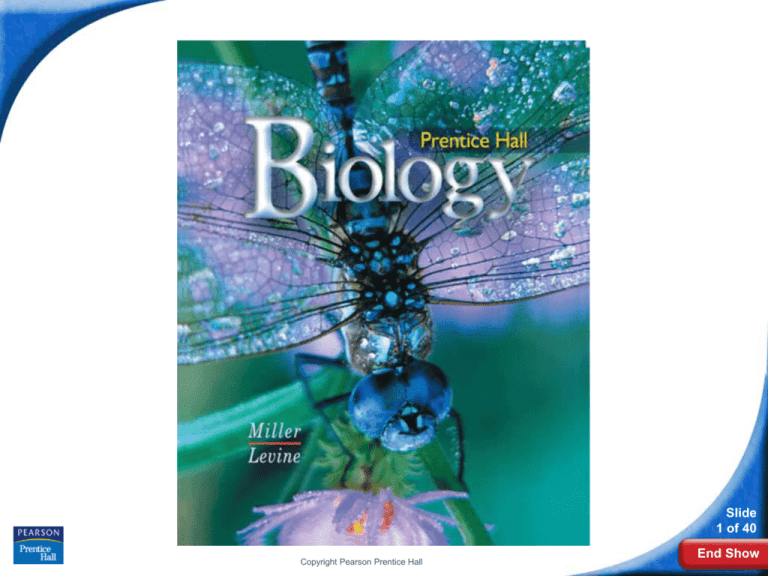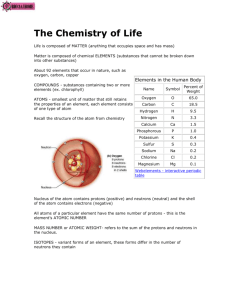
Biology
Slide
1 of 40
Copyright Pearson Prentice Hall
End Show
2-1 The Nature of Matter
Slide
2 of 40
Copyright Pearson Prentice Hall
End Show
2-1 The Nature of Matter
Atoms
Atoms
The study of chemistry begins with the basic unit of
matter, the atom.
The Greek philosopher Democritus called the
smallest fragment of matter the atom, from the
Greek word atomos.
Slide
3 of 40
Copyright Pearson Prentice Hall
End Show
2-1 The Nature of Matter
Atoms
Placed side by side, 100 million atoms would make a
row only about 1 centimeter long.
Atoms contain subatomic particles that are even
smaller.
Slide
4 of 40
Copyright Pearson Prentice Hall
End Show
2-1 The Nature of Matter
Atoms
What three subatomic particles make up
atoms?
Slide
5 of 40
Copyright Pearson Prentice Hall
End Show
2-1 The Nature of Matter
Atoms
The subatomic particles that make up
atoms are
• protons
• neutrons
• electrons
Slide
6 of 40
Copyright Pearson Prentice Hall
End Show
2-1 The Nature of Matter
Atoms
The subatomic
particles in a helium
atom.
Slide
7 of 40
Copyright Pearson Prentice Hall
End Show
2-1 The Nature of Matter
Atoms
Protons and neutrons have about the same mass.
Protons are positively charged particles (+).
Neutrons carry no charge.
Strong forces bind protons and neutrons together to
form the nucleus, which is at the center of the atom.
Slide
8 of 40
Copyright Pearson Prentice Hall
End Show
2-1 The Nature of Matter
Atoms
The electron is a negatively charged particle (−) with
1/1840 the mass of a proton.
Electrons are in constant motion in the space
surrounding the nucleus.
Slide
9 of 40
Copyright Pearson Prentice Hall
End Show
2-1 The Nature of Matter
Atoms
Electrons are attracted to the positively charged
nucleus but remain outside the nucleus because
of the energy of their motion.
Slide
10 of 40
Copyright Pearson Prentice Hall
End Show
2-1 The Nature of Matter
Atoms
Because atoms have equal numbers of electrons
and protons, and because these subatomic particles
have equal but opposite charges, atoms are neutral.
Slide
11 of 40
Copyright Pearson Prentice Hall
End Show
2-1 The Nature of Matter
Elements and Isotopes
Elements and Isotopes
A chemical element is a pure substance that
consists entirely of one type of atom.
Elements are represented by a one- or two-letter
symbol.
• C stands for carbon.
• Na stands for sodium.
Slide
12 of 40
Copyright Pearson Prentice Hall
End Show
2-1 The Nature of Matter
Elements and Isotopes
The number of protons in an atom of an element is
the element's atomic number.
Carbon has 6 protons, so its atomic number is 6.
More than 100 elements are known, but only about
two dozen are commonly found in living organisms.
Slide
13 of 40
Copyright Pearson Prentice Hall
End Show
2-1 The Nature of Matter
Elements and Isotopes
Isotopes
Atoms of the same element that differ in the
number of neutrons they contain are known as
isotopes.
The sum of the protons and neutrons in the
nucleus of an atom is called its mass number.
Slide
14 of 40
Copyright Pearson Prentice Hall
End Show
2-1 The Nature of Matter
Elements and Isotopes
Isotopes are identified by their mass numbers.
For example, carbon has three isotopes—carbon-12,
carbon-13, and carbon-14. Each isotope has a
different number of neutrons.
Slide
15 of 40
Copyright Pearson Prentice Hall
End Show
2-1 The Nature of Matter
Elements and Isotopes
How are all of the isotopes of an element
similar?
Slide
16 of 40
Copyright Pearson Prentice Hall
End Show
2-1 The Nature of Matter
Elements and Isotopes
Because they have the same number of
electrons, all isotopes of an element have
the same chemical properties.
Slide
17 of 40
Copyright Pearson Prentice Hall
End Show
2-1 The Nature of Matter
Elements and Isotopes
Isotopes of Carbon
6 electrons
6 protons
6
7
8 neutrons
Copyright Pearson Prentice Hall
Slide
18 of 40
End Show
2-1 The Nature of Matter
Elements and Isotopes
Radioactive Isotopes
Some isotopes are radioactive, meaning that their
nuclei are unstable and break down at a constant
rate over time
Although the radiation these isotopes give off can
be dangerous, they have important scientific and
practical uses.
Slide
19 of 40
Copyright Pearson Prentice Hall
End Show
2-1 The Nature of Matter
Elements and Isotopes
Radioactive isotopes can be used:
• to determine the ages of rocks and fossils.
• to treat cancer.
• to kill bacteria that cause food to spoil.
• as labels or “tracers” to follow the movement of
substances within an organism.
Slide
20 of 40
Copyright Pearson Prentice Hall
End Show
2-1 The Nature of Matter
Chemical Compounds
Chemical Compounds
In nature, most elements are found combined with
other elements in compounds.
A chemical compound is a substance formed by
the chemical combination of two or more elements
in definite proportions.
The physical and chemical properties of a
compound are different from the elements from
which it is formed.
Slide
21 of 40
Copyright Pearson Prentice Hall
End Show
2-1 The Nature of Matter
Chemical Compounds
Scientists show the composition of compounds by a
kind of shorthand known as a chemical formula.
Water, H2O, contains two atoms of hydrogen for each
atom of oxygen.
The formula for table salt, NaCl, indicates that
sodium and chlorine combine in a 1 : 1 ratio.
Slide
22 of 40
Copyright Pearson Prentice Hall
End Show
2-1 The Nature of Matter
Chemical Bonds
What are the two main types of chemical
bonds?
Slide
23 of 40
Copyright Pearson Prentice Hall
End Show
2-1 The Nature of Matter
Chemical Bonds
Chemical Bonds
The atoms in compounds are held together by
chemical bonds.
Bond formation involves the electrons that
surround each atomic nucleus.
The electrons that are available to form bonds are
called valence electrons.
Slide
24 of 40
Copyright Pearson Prentice Hall
End Show
2-1 The Nature of Matter
Chemical Bonds
The main types of chemical bonds are:
• ionic bonds
• covalent bonds
Slide
25 of 40
Copyright Pearson Prentice Hall
End Show
2-1 The Nature of Matter
Chemical Bonds
Ionic Bonds
An ionic bond is formed when one or more
electrons are transferred from one atom to another.
An atom that loses electrons has a positive
charge.
An atom that gains electrons has a negative
charge.
These positively and negatively charged atoms are
known as ions.
Slide
26 of 40
Copyright Pearson Prentice Hall
End Show
2-1 The Nature of Matter
Chemical Bonds
Sodium ion (Cl-)
Sodium atom (Na)
Sodium ion (Na+)
Sodium atom (Cl)
Protons
Electrons
+11
- 11
10
Protons
Electrons
+17
18
- 17
Charge
+10
Charge
-10
Slide
27 of 40
Copyright Pearson Prentice Hall
End Show
2-1 The Nature of Matter
Chemical Bonds
Covalent Bonds
Sometimes electrons are shared by atoms instead
of being transferred.
Sharing electrons means that the moving electrons
actually travel in the orbitals of both atoms.
Slide
28 of 40
Copyright Pearson Prentice Hall
End Show
2-1 The Nature of Matter
Chemical Bonds
A covalent bond forms when electrons are shared
between atoms.
• When the atoms share two electrons, the bond is
called a single covalent bond.
• When atoms share four electrons it is called a
double bond.
• When atoms share six electrons it is called a
triple bond.
Slide
29 of 40
Copyright Pearson Prentice Hall
End Show
2-1 The Nature of Matter
Chemical Bonds
The structure that results when atoms are joined
together by covalent bonds is called a molecule.
A molecule is the smallest unit of most compounds.
Slide
30 of 40
Copyright Pearson Prentice Hall
End Show
2-1 The Nature of Matter
Chemical Bonds
In a water molecule, each
hydrogen atom forms a
single covalent bond with
the oxygen atom.
Slide
31 of 40
Copyright Pearson Prentice Hall
End Show
2-1 The Nature of Matter
Chemical Bonds
Van der Waals Forces
When molecules are close together, a slight
attraction can develop between the oppositely
charged regions of nearby molecules.
Chemists call such intermolecular forces of
attraction van der Waals forces, after the scientist
who discovered them.
Slide
32 of 40
Copyright Pearson Prentice Hall
End Show
2-1 The Nature of Matter
Chemical Bonds
Although van der Waals forces are not as strong
as ionic bonds or covalent bonds, they can hold
molecules together, especially when the molecules
are large.
Slide
33 of 40
Copyright Pearson Prentice Hall
End Show
2-1 The Nature of Matter
Chemical Bonds
For example, van der Waals
forces form between the
molecules on the surface of
a gecko’s foot and the
molecules on the surface of
the wall.
The combined strength of all
the van der Waals forces
allows the gecko to grip the
wall.
Slide
34 of 40
Copyright Pearson Prentice Hall
End Show
2-1
Click to Launch:
Continue to:
- or -
Slide
35 of 40
End Show
Copyright Pearson Prentice Hall
2-1
The particles that move around the nucleus of
an atom are called
a. neutrons.
b. protons.
c. electrons.
d. isotopes.
Slide
36 of 40
End Show
Copyright Pearson Prentice Hall
2-1
The atomic number of a carbon atom is 6. How
many neutrons does the isotope carbon-14
have?
a. 6
b. 8
c. 12
d. 14
Slide
37 of 40
End Show
Copyright Pearson Prentice Hall
2-1
Which of the following statements about the
three isotopes of carbon is true?
a. They are all radioactive.
b. They have different numbers of electrons.
c. They have the same chemical properties but
differ in atomic mass.
d. They have the same number of protons and
neutrons.
Slide
38 of 40
End Show
Copyright Pearson Prentice Hall
2-1
A chemical compound consists of
a. Electrons mixed with neutrons.
b. two or more elements combined in a definite
proportion.
c. two or more elements combined in any
proportion.
d. at least three elements combined by ionic or
covalent bonds.
Slide
39 of 40
End Show
Copyright Pearson Prentice Hall
2-1
Van der Waals forces are the result of
a. unequal sharing of electrons.
b. ionic bonds.
c. the bonding of different isotopes.
d. the chemical combination of sodium and
chlorine.
Slide
40 of 40
End Show
Copyright Pearson Prentice Hall
END OF SECTION







